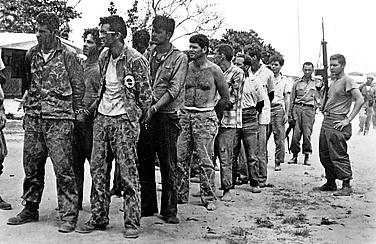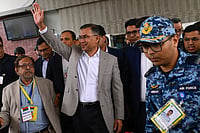The political crisis that has gripped Belarus for the past 18 months has seen president Aliaksandr Lukashenka (the preferred Belarusian spelling; “Alexander Lukashenko” is the Russian transliteration) transition from a peacemaker to a pawn in Vladimir Putin’s war on Ukraine.
After hosting talks in 2015 to end fighting in eastern Ukraine, Belarus has now opted to facilitate the Russian attack on its neighbour. In doing so, Lukashenka has surrendered the sovereignty of his own state without a single shot being fired on its territory.
The relationship between Minsk and Moscow has a long and complicated history. Until the 2020 Belarusian revolution, Lukashenka maintained a cautious independence in foreign policy. This included keeping the Russian military out of Belarus.
The fraudulent presidential elections of August 2020, however, sparked the largest protests in the country’s modern history. Faced with the greatest popular challenge in his 26 years in power, Lukashenka was quick to churn out anti-Nato rhetoric, aimed at Putin as much as at domestic audiences.
He claimed the west was fomenting the protests to destabilise Belarus and turn it into “the bridgehead against Russia”. This strategy worked. In Lukashenka’s vulnerable position the Kremlin saw an opportunity and offered support.
A Soviet republic
Belarus first appeared on the world map after the first world war. The 1917 revolution in Russia brought down the tsarist empire. German occupation of the latter’s Belarusian lands enabled local nationalists to proclaim the Belarusian People’s Republic in March 1918. After Germany’s collapse, the Bolsheviks returned to establish a Soviet Belarusian republic in 1919. And in the chaotic years that followed, a large portion of Belarusian land went to Poland under the 1921 Riga Peace Treaty.
Soviet Belarus was a founding member of the Union of Soviet Socialist Republics (USSR) in 1922 and enjoyed a brief period of nation-building under the auspices of what historian Terry Martin terms Moscow’s affirmative action. This Soviet policy sought to win over non-Russian minorities in the multi-ethnic union by promoting their native languages and cultures and by training local cadres.
From the late 1920s on, however, this process of Belarusisation was curtailed. Stalinist repressions of the 1930s hit Belarus harder than many other republics and its cultural elites were decimated.
The 1939 Molotov-Ribbentrop pact of non-aggression between Nazi Germany and the USSR nearly doubled Belarus’s prewar territory, gains which were not reversed after 1945. The second world war saw Belarus suffer terribly, however, losing a greater share of its population than any other European country did.
The war left deep scars on the national psyche but also served to cement the country’s place in the Soviet empire. Post-war investment from Moscow poured in. By the 1970s, Belarus was one of the most economically successful Soviet republics.
A complicated relationship
The stability and prosperity of the final Soviet decades made many Belarusians reluctant to see the USSR die. And even before Lukashenka was elected president in 1994, Minsk pursued closer economic and political ties with Russia.
Lukashenka quickly grasped that economic integration with Russia was a good idea. He pushed for economic and foreign policy cooperation between the two countries. In 1999, Belarus and Russia signed a treaty establishing the Union State. This vaguely defined entity saw both states retain their sovereignty but share some supranational institutions.
Most of the larger integration goals – a single currency; common taxation; a joint defence policy – never materialised, however. And the relationship between the two states was further strained by Belarus’ dependence on Russian energy resources, with Lukashenka routinely haggling with the Kremlin over concessionary prices for Russian gas and oil.
Belarusians, meanwhile, might have close affinity with Russia (most being Russian speakers) but they baulk at the idea of a full merger with the Russian Federation. This is partly a new habit of independence. It is also a legacy of that conflicting approach to nationalities in the later Soviet era, when ethnic identities of individual republics were promoted alongside the supra-ethnic Soviet identity. The Belarusian nation-building process did not start from scratch in 1991. It had begun well before the country gained independence from the USSR.
Pivotal moment
Putin’s aggressive stance on Ukraine from the early 2010s initially worried Lukashenka. Concerned about the precedent it might set for Belarus, he used nationalist rhetoric to distance his government from Russia, even as Moscow grew keener to integrate the two nations.
In 2014, Lukashenka avoided formally recognising Russia’s annexation of Crimea and instead made overtures to the west. By 2020, relations with the Kremlin had reached a new low.
And then 2020 happened. Lukashenka’s violent crackdown brought on Western sanctions, which intensified after Minsk hijacked an international flight over its airspace. He manufactured a migrant crisis on the Polish border, which earned Belarus widespread condemnation and further sanctions.
A night scene of an ambulance in front of a large facility with lights and people waiting outside.
By the end of 2020, relentless repression had forced the protest movement underground. Belarus currently has 1,076 political prisoners, but thousands more were detained, and scores fled the country to escape persecution.
Meanwhile, in November 2021, Minsk and Moscow signed a comprehensive economic integration programme and agreed a joint military doctrine. Lukashenka’s international isolation gave Putin a new ability to force Minsk to accept the presence of Russian troops on the Belarusian-Ukrainian border, only 50 miles from Kyiv.
This undoubtedly played a key role in Moscow’s decision to attack Ukraine. And while Minsk has claimed that its troops are not yet involved, Belarus has nonetheless taken steps to reverse its 1994 decision to abandon nuclear weapons. On February 27, 2022, a national referendum scrapped the country’s constitutional pledge to remain nuclear-free.
The Lukashenka regime has long falsified electoral outcomes and this referendum was no different. Anti-war sentiment remains strong among Belarusians, as demonstrated by the hundreds of protestors on the referendum day who came out to show solidarity with Ukraine; 800 were arrested.
Exhausted by repression and with their opposition leaders exiled or imprisoned, ordinary Belarusians have few tools at their disposal to effectively resist the government. If they were to try to fight Lukashenka, the state army and special forces would likely be used against them. But if Lukashenka decides to throw his army into Putin’s war, this could all change.
(Source- The Conversation)


























